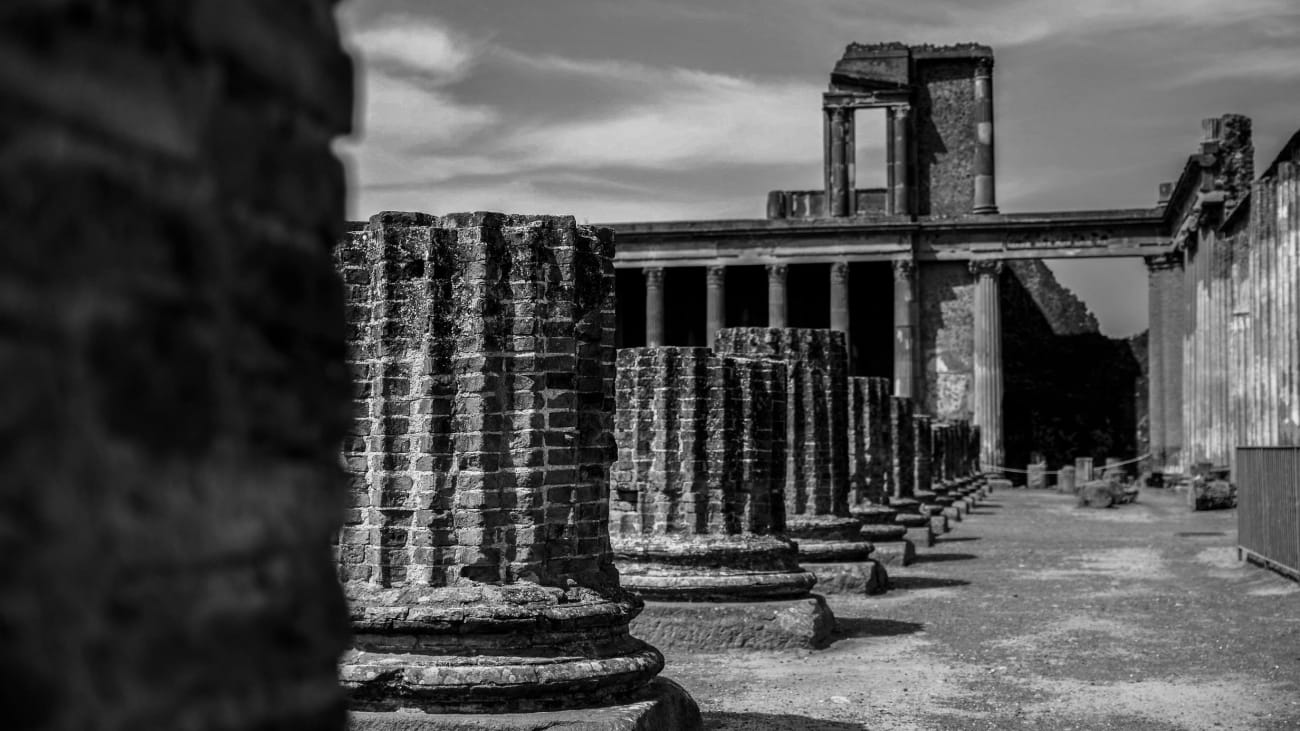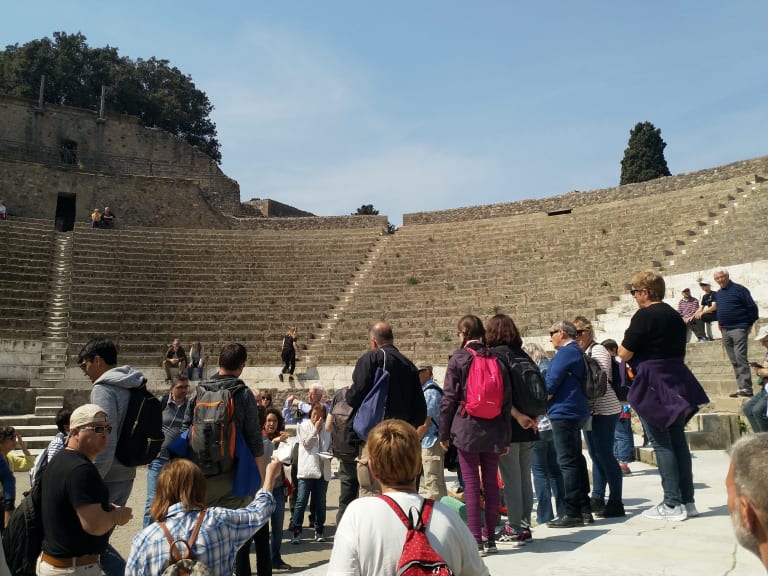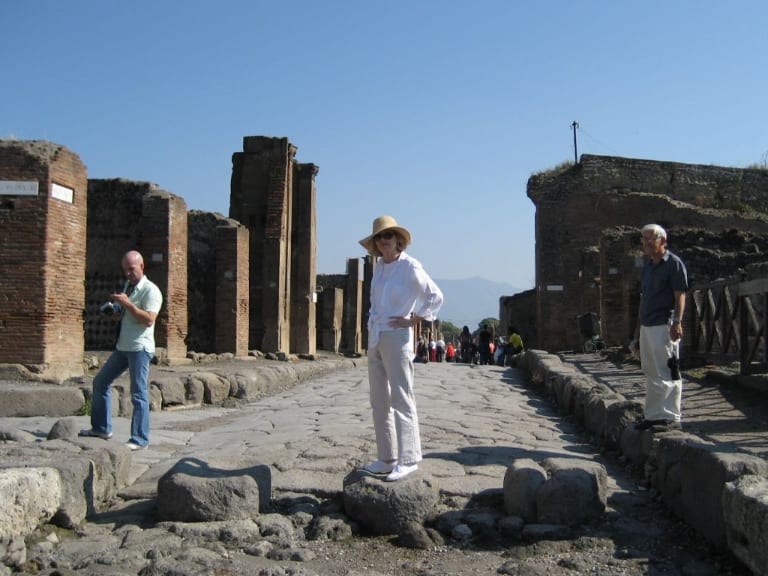Tips to Visit Pompeii
A visit to Pompeii is a must in every traveller's passport. However, there are a few tips that will help you to make the journey much more complete and unforgettable. Take note of them!

Archaeological remains in Pompeii | Vladimir de Vico
Pompeii doesn't need much introduction: it is one of the best-preserved Roman cities, despite the fact that the lava from Vesuvius completely petrified it in the year 79. Today it can be visited, you can walk through its authentic streets, visit some of its temples, theatres and houses and understand what life was like there for its citizens.
To get the most out of your trip to Pompeii, take note of the following essential tips and I assure you that your visit will go smoothly.
1. A guided tour is always better than touring on your own

A place with so much detail, history and context is much more enjoyable with an expert guide who accompanies you and explains what you are seeing at all times. There is so much to see and do in Pompeii that if you visit on your own you will be missing out on much of the significance of the place.
In addition, the guide will tell you more about the daily life of the citizens, how the eruption of the volcano affected them and what happened to Pompeii after that fateful episode.
Trust me, if you've come this far, have a guide to visit the place and your experience will be that much more interesting. Have a look at my article if you are thinking of booking a tour to Pompeii from Rome.
2. Book your tickets or tour in advance

Whatever you decide, book as soon as possible. More than 4 million visitors come to Pompeii every year and you don't want to get there and miss out on tickets or have to queue endlessly to get inside tired. You can read more about how to get tickets to Pompeii here.
As I said, a guided tour will make you enjoy the place much more, but whether you are in Naples or coming from Rome, joining a guided tour that includes the round trip will simplify the logistics and help you not to have to worry about anything.
Remember, it's best to book online so you can compare rates, times, availability and route types (some tours include a volcano climb or even a walk or a meal in Naples) - you'll be spoilt for choice!
3. Protect yourself from the sun and heat

It's obvious that it's very hot in summer, but you should also be aware that Pompeii is not very shady, so after several hours of walking around the city, you'll be thankful that you're well prepared against the sun and the high temperatures.
Wear cool, comfortable clothes, avoid dark colours, bring a hat or cap, sunscreen and plenty of fresh water. Bottled water and soft drinks are available on site.
July and August tend to be the hottest months and the middle of the day is inevitably the hardest, but if you're well prepared you should be fine. In spring and autumn temperatures are usually much milder, but even so, don't forget a hat to protect you from the sun just in case, and check the weather forecast a few days before your visit to prepare yourself.
4. Comfortable shoes: a must for this excursion

You get to know and enjoy Italy on foot. And Pompeii is no exception. Its cobbled streets, archaeological remains, the palaces and temples that are still standing... Bear in mind that the tour of the city will be done entirely on foot along the cobbled streets of the period.
So, as you can imagine, comfortable shoes will be your greatest ally on this excursion. If you go in the hot season, this rule becomes even more essential. Avoid sandals that don't fit snugly, heels (of course), narrow shoes, etc.
Make yourself comfortable and get ready to enjoy a unique place from which you will want to take many memories (but not unbearably sore feet!).
5. Make the most of your visit to Pompeii if you go with children

A visit to Pompeii is always a great day out for the little ones, but like any outing with children, it has its tricks. Wrap them up warm in winter and protect them from the sun and heat in summer: you'll be spending most of the day outdoors. Fresh water and snacks are a must in your backpack.
They will also need comfortable shoes (the pram can fit, although the cobbled streets are not always comfortable) and take it easy because they will need to take a break along the route.
A good idea is to tell them a bit of the history of the place before arriving, so that they are immersed in the context and understand a little better what they are going to see. Here is an article with more tips for visiting Pompeii with children. Enjoy!
6. Go to the Vesuvius Crater

Vesuvius defines the skyline that frames the town of Pompeii, and peering into its crater will make all the difference to your visit. If you're feeling strong enough (the climb is quite steep, so be aware that it requires some effort) you'll be rewarded with the best views in the area.
Take the opportunity to recharge your batteries after visiting Pompeii and before the climb up the volcano, but don't rule it out - I can assure you it's worth it and when you're at the top you' ll be glad you went up. On the way down, a good pizza awaits you to compensate for the effort. Here is an article to give you all the information you need about visiting Mount Vesuvius.
By the way, if you want to know more about the city and how the tragedy originated, a good idea is to watch the film Pompeii before your trip.
7. Avoid weekends

This is probably the number 1 rule to follow when it comes to visiting a tourist attraction and this case is no different. Unlike other places like museums or even the Colosseum itself, you will never feel crowded here as everything is outdoors. But walking the cobblestone streets of Pompeii with fewer people will give you a more real experience, connecting you more with the place and putting you in the role of the tour. Read more about the best time to go to Pompeii here.
This also applies to public holidays, long weekends or high season periods, when there may be more tourists than usual. In any case, remember that booking your ticket or guided tour in advance will make the experience much better.
In fact, if you can avoid the summer heat, you will be grateful: the temperatures, the sun and the number of visitors can make the visit more stifling.
8. Take the opportunity to get to know Naples (or at least its pizzas)

The proximity of Naples and Pompeii ( only 23 km away) makes Naples a great place to end the day after an exhaustive visit to the archaeological remains of Pompeii.
Its lively atmosphere, monumental squares and authentic neighbourhoods will transport you to another Italy that you'll love to explore. Even if you don't have much time, if you can fit it into your agenda, don't hesitate to pay a visit to this emblematic city.
And, above all, take the opportunity to sit on one of its typical terraces with chequered tablecloths and order an authentic Neapolitan pizza.
9. Don't carry too much weight in your backpack

The walk can be a long one and although you may think you'll need a lot of things throughout the day, if you're well-shoed and protected with a hat, you won't need much more.
Take a bottle of water with you but you can buy more fresh bottles on the spot when you need them, so there's no need to carry too much weight, especially if you're travelling by public transport, where you won't be able to leave anything on the bus or train.
The whole of Pompeii is on foot and if you're going up Vesuvius, the climb is quite demanding, so you'll be glad you're light on your luggage.
10. Take the best photos of Pompeii and put your camera away

The wonders you are going to see in Pompeii will make you want to play with your camera, take pictures from different perspectives of the cobbled streets, the temples, the theatres, the amphitheatre, the forum.... But don't give in to the temptation to keep looking for the best frame.
For me, the best photos of Pompeii are taken from a more distant perspective that gives you a frame of the entire archaeological complex, its vastness and the famous Vesuvius in the background. Those are the landscapes you'll conjure up when you're back home again and again.
As for the rest of the tour, capture the essential places, the ones that make the most impact on you, and put your camera away to continue enjoying the tour and listening to your guide!
